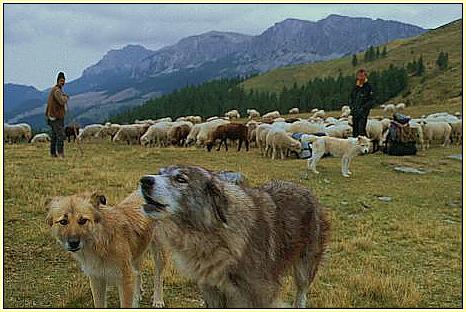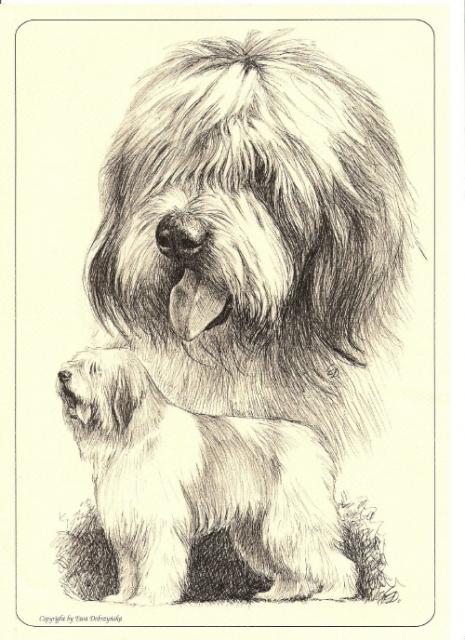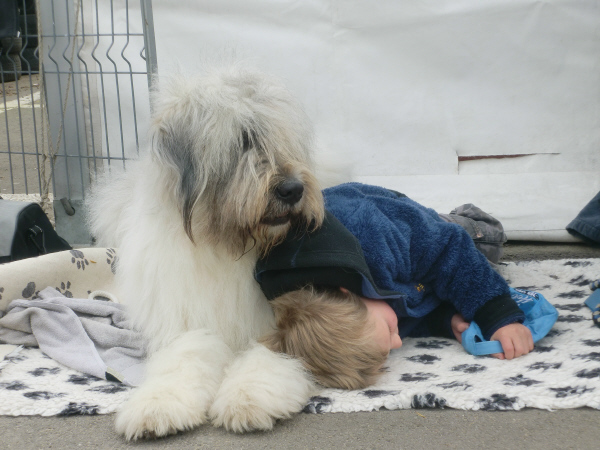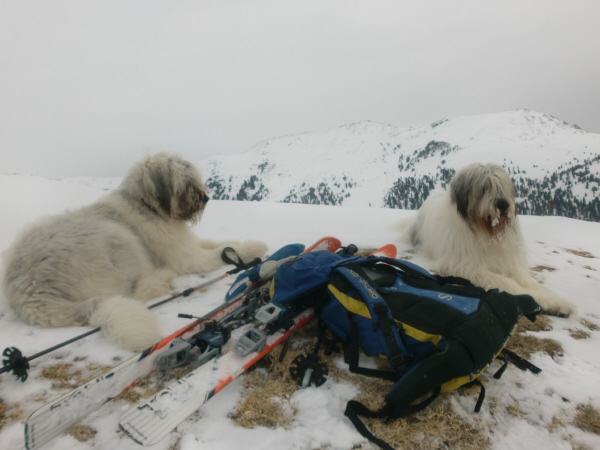Ciobanesc romanesc mioritic
 The Carpathian Mountains dictate Romania`s landscape. It is here that the traditions of shepherds remain unchanged. Powerful herding/guard dogs protect large sheep and goat herds from bears, wolves, large cats, predatory birds, as well as 2-legged poachers.
The Carpathian Mountains dictate Romania`s landscape. It is here that the traditions of shepherds remain unchanged. Powerful herding/guard dogs protect large sheep and goat herds from bears, wolves, large cats, predatory birds, as well as 2-legged poachers.
The Romanian herding dogs (Ciobanesc Romanesc) are thus extremely protective and well versed in their original guarding function.
Archelogical dogs have proven the existence of large guard dogs as far as back as the middle of the Neolithic period. Lend-lease agreements of grazing-lands dating back to the 15th – 18th centuries indicate large numbers of herding dogs enlisted for the protection of the diverse herds. In 1975, Romania cartograpically categorized approximately 6.500 working dogs.
The FCI currently recognizes 3 breeds of Ciobanesc Romanesc: Ciobanesc Romanesc Carpatin (FCI-Nr. 350), Ciobanesc Romanesc Bukowina (FCI-Nr. 357) and Ciobanesc Romanesc Mioritic (FCI-Nr. 349)
In 1934/35, the Romanian Institute for Zoology released the first desrciptions of the Carpatin and Mioritic breeds. The Mioritic (mioritica = small sheep) is a powerful, agile, approximately 70cm tall, shaggy dog. Its thick and fluffy hair, also covering its face to include a bearded chin, is characteristic of the breed. The dog´s coat is mostly white, though it can vary between yellowish, brownish, and even light grey with black or grey markings.
The first breed registry opened in 1938. In 1969, the Ministry of Agriculture sponsored research and breeding in order to ensure the refinement of the breed. In 1981, as a result of the large dog exhibition in Radauti, the breeding standards for the Mioritic (dog of the Romanian lowlands) and the Carpatin (dog of the mountainous regions) were defined. On 6 July 2005, the FCI provisionally recognized the Carpatin and Mioritic breeds. The Bukowina was recognized on 26 March 2009. In June 2016 at Worlddogshow in Milano Carpatin and Mioritic were officially recognized.

♦FCI-Standard N° 349 / 29.9.2005
CIOBANESC ROMANESC MIORITIC
UTILIZATION.: excellent herding dog, incorruptible guardian and marvellous companion
CLASSIFICATION FCI: Group 1 Sheepdogs and Cattle Dogs (except Swiss Sheepdogs); Section 1 Sheepdogs without working trial
BRIEF HISTORICAL SUMMARY. The Romanian Mioritic Shepherd Dog was selected from a natural breed of the Carpathian mountains, the principle reason being utility. This breed has many fanciers in Romania because of its vigorous appearance.
The standard was drafted by the Romanian Cynological Association in 1981. The Technical Commission of the R.C.A. adapted and revised the Standard on 29.3.2002 to conform to the FCI model established in Jerusalem.
GENERAL APPEARANCE: a large dog but never heavy; vigorous and spectacular; the coat is long and well furnished on the head, all of the body and the limbs. Males are taller and stronger than females.
IMPORTANT PROPORTIONS:
♦length of the body / height at withers 11 : 10
♦depth of chest should be approximately half of the height at the withers
♦ the muzzle is slightly shorter than the skull
BEAHIOUR / TEMPERAMENT: a calm and stable dog, a good herding dog, very courageous and efficient fighter against possible prey (bear, wolf, lynx); wary of strangers; he likes children
HEAD
CRANIAL REGION:
SKULL: moderate width, slightly domed. The upper profiles of the skull and muzzle are almost parallel. Seen from the front the upper line is slightly domed. The zygomatc arches are only slightly defined. Occipital protuberance weel defined
Stop: not too pronounced
FACIAL REGION:
Nose: wide, well developed, black
Muzzle: a little shorter than the skull; well developed, tapering progressively towards the nose but never pointed; strong underjaw
Lips: thick, tight, strongly pigmented
Jaws/Teeth: powerful jaws; complete dentition; strong and healthy with well set white teeth; scissor bite
Cheeks: not protruding
Eyes: moderate size, oblique; the colour is hazel, dark brown or slightly lighter, never yellow; eyelids well pigmented; calm and intelligent expression
Ears: relatively high set, “V” shaped with the tip slightly rounded, 10-15cm long, hanging closely to the cheeks; cropping forbidden
NECK: moderate length, broad and powerful, without dewlap
BODY: well developed
Topline: straight and solid
Withers: moderately defined
Back: horizontal, strong and muscled
Loin: moderately long, wide and very muscular
Croup: muscled and moderately sloping towards the base of the tail
Chest: not too long, broad, depth being approximately half of the height at the withers, ribs well sprung
Underline: slight tuck up without being whippety
TAIL: high set-on, at rest it is carried hanging, reaching or lower than the hock; when the dog is alwert or in action, the teil is carried higher, slightly curved, sometimes above the topline but never curled over the back; docking is forbidden
LIMBS
FOREQUARTERS: upright, seen from the front or the side
Shoulder: moderater lenght, oblique, very muscular and well attached. The scapula-humerus angle is approximately 100°-105°
Upper arm: moderate lenght, well muscled
Elbow: close to the body, turning neither in or out
Forearm: sufficiently long, powerful and muscled
Carpal joint: firm
Metacarpus (pastern): slightly sloping seen from the side
Feet: oval, compact and massive, toes are tight and arched, nails ash-grey colour
HINDQUARTERS: very muscular and powerful, straight and parallel seen from behind; angulattions onlyslightly open
Upper thigh: long, broad and very muscular
Stifle: The femur-tibial angle is approximately 100°-105°
Lower thigh: sufficiently long, muscled with good bone
Hocks: moderate height, strong, well bent, turning neither in nor out
Metatarsus (rear pastern): not too long, robust and almost vertical, seen from the side. The presence of dewclaws should not be penalized.
Feet: slightly longer than the front feet
GAIT / MOVEMENT: harmonious, free, well coordinated, powerful and effortless. The trot is preferred. The gallop is sutained and balanced.
SKIN: thick, tight fitting and well pigmented
COAT
HAIR: The coat is abundant and the head and body, harsh texture, straight and minimum lenght of 10cm. The undercoat is more dense and supple and of a lighter colour. On the limbs the coat is shorter. The tail is well furnished.
COLOUR:
Piebald: The ground colour must be white with well defined black or grey markings.
Solid colours: solid white or solid grey
SIZE AND WEIGHT:
Male: minimum 70cm – ideal height 75cm
Female: minimum 65 – ideal height 70cm
Weight: in proportion to the size
FAULTS: Any departure from the foregoing points should be considered a fault and the seriousness with which the faults should be regarded should be in exact proportions to its degree.
♦ overweight or weak subject
♦ tail curled or carried in a ring
♦ absence of teeth, other than PM1
♦ elbows turned in or out
♦ heavy gait
SERIOUS FAULTS:
♦ sexual characters not sufficiently marked
♦ untypical expression
♦ round, protruding eyes
♦ wall eye
♦ erect ears
♦ coat too short (less than 8cm)
♦ curly coat or of a texture other than described in the standard
♦ topline sagging, arched or dipping
♦ spreading feet, turned out or in
♦ rear limbs: angulation too open
♦ cowhocks
♦ presence of brindle markings
ELIMINATING FAULTS.
♦ aggressive or overly shy
♦ untypical subjekt
♦ absence of incisives or canines
♦ overshot or undershot
♦ albinism
♦ naturally absent or naturally short tail
♦ docked tail
♦ height at the withers less than 68cm for males and 63cm for females
Any dog clearly showing physical or behavioural abnormalities shall be disqualified.
N.B.: Male animals should have two apparently normal testicles fully descended into the scrotrum.
 The Mioritic has typical shepherd dog qualities. Its personality is characterised by strong independence and a high self confidence. The main task of the shepherd dog is the impressive deterrence of all possible troublemakers. It need not be trained for that, it simply knows it. From early youth onwards one must teach the dog not to make use of his set of threatening behaviours (self-display, barking, showing). It clearly differentiates between unknown and familiar. It is friendly and reliable towards all acquaintances but shows refusal and mistrust towards strangers. Only after close examination are they accepted in its elitist circle of friends.
The Mioritic has typical shepherd dog qualities. Its personality is characterised by strong independence and a high self confidence. The main task of the shepherd dog is the impressive deterrence of all possible troublemakers. It need not be trained for that, it simply knows it. From early youth onwards one must teach the dog not to make use of his set of threatening behaviours (self-display, barking, showing). It clearly differentiates between unknown and familiar. It is friendly and reliable towards all acquaintances but shows refusal and mistrust towards strangers. Only after close examination are they accepted in its elitist circle of friends.
The Mioritic is very loyal, affectionate, reliable, understanding, and willing to compromise towards its pack, its family or owner. It is a tolerant, gentle friend for children and it is willing to act as a cuddly blanket but it is not really fond of playing.
All shepherds are extremely territory conscious and they are incorruptible guardians. But their territory does not end at the property gate! It can be anywhere where the pack is or stays. Everything is guarded that can be seen from a watch post usually chosen at an elevated place.
 Our shepherds are lively and stubborn but in spite of all their independence they are very sensitive creatures in their furry armour. As puppies they stick to the pack which has accepted them. This can be any kind of creature – dog, cat, horse, sheep, …The Mioritic needs very close family ties; a house without doors it thinks ideal. In our climate this certainly depends a great deal on the weather. Its favourite place is always very close to its favourite person. It determines its resting place itself. This may even be the couch or a carpet not suitable for dogs, but as a rule shepherds, even as puppies, prefer to sleep on hard ground. They need no dog baskets, no special mattresses and by no means an allocated place. In our house we have distributed dog blankets (Vet-BED) which they occupy at their own discretion.
Our shepherds are lively and stubborn but in spite of all their independence they are very sensitive creatures in their furry armour. As puppies they stick to the pack which has accepted them. This can be any kind of creature – dog, cat, horse, sheep, …The Mioritic needs very close family ties; a house without doors it thinks ideal. In our climate this certainly depends a great deal on the weather. Its favourite place is always very close to its favourite person. It determines its resting place itself. This may even be the couch or a carpet not suitable for dogs, but as a rule shepherds, even as puppies, prefer to sleep on hard ground. They need no dog baskets, no special mattresses and by no means an allocated place. In our house we have distributed dog blankets (Vet-BED) which they occupy at their own discretion.
No “work creating” program is necessary but daily walks and hikes provide exciting variation. They certainly do not despise holidays with the whole family in the mountains at any time of the year.
Despite the breed´s scraggly fur, our dogs are very low-maintenance. They do not require a bath, nor daily brushing. In the event that they become wet or totally filthy, the dogs are simply confined for a time, until the dirt, mud , or what-not may be easily brushed out. A dry Mioritic is a clean Mioritic.
Besides the daily monitoring of eyes, ears, and teeth, the dogs also undergo a thorough grooming once a week. The pups are accustomed to the grooming procedures early on as part daily training, since grooming serves establish hierarchy: The dog allowing the grooming, accepts the dominance of the one doing grooming.
Our dogs, especially Happy, are extremely eager when they take part in Obedience/Agility training
The contact between child and dog must also be learnt. Above all it must be made clear to the child that it should not try to dominate the dog. I must protect the dog (not the child) from “attacks”. Shepherds are the most tender and patient dogs for children. They are the softest cuddling blankets but they do not like to play.